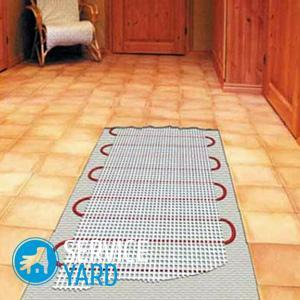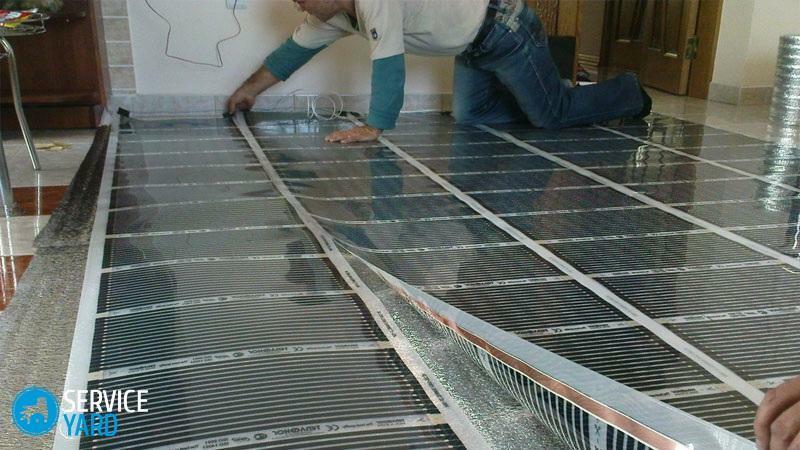
- Types of electrical floors
- What do I need for mounting?
- Align the floor and lay the insulation
- Calculate the cable and prepare for laying
- Install the thermostat
- Lay the cable
- Cable laying rules:
During construction or repair, homeowners always think about how to make living more comfortable. Nowadays the device of a warm floor is very popular. But many people reject this idea, since installation works are very expensive. But you can save and make an electric warm floor with your own hands. How?- Read our article.
to the table of contents ↑Types of electric floors
The modern heated floor connected to the mains is presented in the form of a cable system or TEN connected to mats. A separate group consists of innovative designs, which include infrared rods, and film models.
But all these options have a number of common features:
- The floor base before installation must be dry;
- Mandatory earthing and thermal insulation;
- The equipment has a thermostat;
- Lifetime - long enough.
But there are differences, presented by the features of installation, the quality of heat produced, interaction with floor coverings.
Cable warm floor
- This system has already become a classic, as the design is very convenient and reliable.
- This floor consists of a cable cut by sections, a sensor for temperature control and a temperature controller.
- Thus, the system switches on only after the temperature has dropped below a certain level.
Important! You can use simple thermoregulators, and more sophisticated devices that monitor not only the temperature of the floor, but also the temperature on the street.
Thermomat( thin cable floor on the mesh):
- A very thin cable fixed to a fiberglass mesh is used for manufacturing.
- The heating conductor in the cable surrounds the shield, insulation and protective sheath.
- The cable in mats can be single- and double-core. Two-core models are used to heat rooms in which people are constantly, because they are distinguished by a low level of electromagnetic radiation.
Important! A thin cable floor is laid on the old tile or the finished screed. For laying under the tile, this option will be the most optimal.
Infrared warm floor
In this type of floor, the heating element, through which an electric current passes, begins to emit electromagnetic waves, thereby raising the temperature of all objects that are in their way. In this there is a similarity between the infrared floor and the sun's rays. Heat from the conductive element passes into the floor covering, which lies on top, and from it the heating of air already takes place.
Different types of flooring are required for different types of flooring:
- Cable flooring and thermometers - ceramic tiles, laminate or granite tiles should be chosen;
- Infrared film and carbon fiber rods - laminate, carpet, linoleum or wood.
What is needed for installation?
Before you learn how to lay a warm electric floor with your own hands, you should determine the necessary tools and materials.
So, you have to get:
- Thermal insulation( expanded polystyrene or polyethylene foam with a layer of foil);
- Dowels or special glue;
- Grid for plaster;
- Primer;
- Dowels with washers or clips made of plastic;
- Cable;
- Thermoregulator and mounting box for it;
- Thermal sensor;
- Corrugated plastic tube;
- Puncher;
- Alabaster;
- Sand and cement;
- Fiberglass and plasticizers;
- Mounting tape;
- Toothed spatula;
- The container in which the solution will be mixed.
When everything is ready, you can proceed with the installation work.
to the contents ↑Align the floor and lay the thermal insulation
Electrical heated floor with our own hands, installation and laying starts with a thermal insulation layer:
- The most common case is polystyrene foam with a density of 35.
- If the bottom is a room that is heated, its thickness should be 20 mm, and if not heated - 30-50 mm.
- The exception is private houses with a concrete foundation laid on the ground. In this case, the thickness of the insulation must be at least 100 mm.
Lay the insulation layer after the floor is completely level. It should be free of pits, cracks and distortions.
Important! In the presence of defects in the screed, they are disposed of with cement. If there is a skew and significant damage, you need to make a new screed.
 When the floor has become level, the time for laying the thermal insulation material comes:
When the floor has become level, the time for laying the thermal insulation material comes:
- The whole surface is treated with a primer. This stage is necessary in order to prevent the formation of fungus and mold.
- Adhesive insulation or fix with dowels.
- We lay the plaster mesh, fix it with the help of special clips made of plastic or dowels with hats.
Important! The length of dowels should be equal to the thickness of the layer of thermal insulation. With this fastening, the insulation is even better fixed.
to the contents ↑Calculate the cable and prepare for laying the
To ensure that the heating is productive, the cable must cover at least 80 percent of the room. Before the start of the laying process, the resistance of the cable sections must be checked, a deviation from the passport values of about 10 percent is allowed.
Important! The cable does not need to be stacked in places where heavy household appliances or furniture are.
When laying the cable from the walls, you need to retreat by six to seven centimeters.
Important! Calculating the laying step of the cable, the following formula should be used: centimeters in step = heated area x 100 / cable length.
to the contents ↑Installation of the
thermostat Act as follows:
- Prepare a hole in the wall, shtrobim furrow to the floor.
- In the hole we insert the junction box, fix it with alabaster.
- The corrugated tube coming out of the box fits into the furrow and is covered with alabaster on top.
- The end of the tube is output to the heating zone and is located between the cable loops so that the thermostat is in the center.
Important! We lay the pipe without bends, in the location of the thermal sensor it is necessary to create an elevation with the help of a wooden bar. So do in order to achieve the location of the sensor immediately under the floor, and therefore - for the correctness of its readings.
- The end of the tube is tightly wound with an insulating tape so that no solution enters it.
We lay the cable
Before making the electric heating floor, it is necessary to study the cable laying rules. It fits in the form of a snake, while you must observe the previously measured step:
- We lay the cable, fix it with the help of screeds made of plastic.
- Check whether the system is functional.
- To assemble the screed, a mixture of sand and cement is used, in proportion 3 to 1.
Important! The solution can be supplemented with suitable plasticizers or ready-mixed compounds. It is possible to add fiber.
- The mortar that is laid on the mesh with the cable must have a thickness of at least 4-5 cm.
- When the screed has dried, a floor covering is laid.
Important! For at least a month, the inclusion of a warm floor is prohibited, since the screed does not have time to dry completely.
to the contents ↑Cable laying rules:
- When choosing a heating cable, the length is calculated based on the area on which heavy furniture will not stand.
- Do not cut the cable.
- Switching to the mains until the screed or adhesive is completely dry will cause a malfunction of the cable.
- The surface for laying the cable must be clean, for this you can use an industrial vacuum cleaner.
- The sensor should not be embedded in the solution - it is better if it is located in the corrugated tube, so it is easier to replace it in the event of a breakdown.
- Where the cable is heated, there should not be air pockets in the screed. Otherwise - it can overheat and break.
As you can see, you can install a floor heating yourself. But without the skills it is unlikely to succeed. If you are not sure that you will cope, it is better to call specialists for help.



